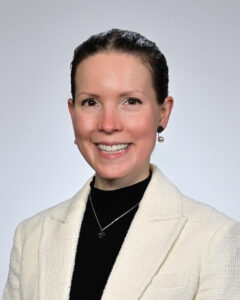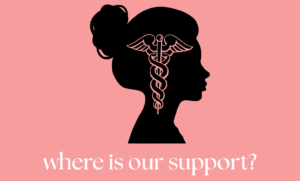Authors: Rhea Manohar, MPH; Meghan Etsey, Ariela Marshall, MD —- on behalf of AMWA Gender Equity Task Force
In nearly every sector of society, women outlive men. This gender-based survival advantage has been consistent for decades—until you step into the world of medicine. A new analysis published by Time highlights an intriguing trend: female physicians are dying at the same rate as their male counterparts, effectively erasing the typical longevity gap that women experience in other professions (Worsham & Jena, 2025). This finding from a groundbreaking study in JAMA Internal Medicine (Patel et al., 2025), reveals that medicine may uniquely penalize women in ways that threaten not just their careers, but their lives. The study examined over 4,000 physician deaths and found that female physicians had no mortality advantage over male physicians, in stark contrast to female lawyers or engineers who maintain a 30–40% lower risk of death compared to their male peers (Patel et al., 2025). In essence, while professional women in other sectors still live longer, women in medicine lose this edge. This highlights the impact of the pressures of the profession, systemic inequities, and unrelenting stress on female physicians.
One of the most painful facets of this crisis is the issue of physician suicide. A 2023 systematic review published in The BMJ found that female physicians have a significantly elevated suicide risk, even when accounting for known stressors and psychiatric history (Zimmermann et al., 2024). This trend is not new. A meta-analysis dating back to 2004 already flagged that women in medicine had a suicide rate up to 2.27 times higher than the general female population (Dobson 2007). Despite widespread awareness of physician burnout, the numbers have barely moved.
What makes the medical field so distinctively harmful? For one, female physicians consistently report higher rates of burnout, harassment, and work-life conflict compared to men (Patel et al., 2025). These aren’t just annoying inconveniences—they are chronic stressors that wear down health over time. Moreover, many female doctors shoulder a “second shift” at home, responsible for a disproportionate share of childcare and household duties, even while managing high-stakes clinical workloads (Caperelli Gergel & Terry, 2022). Importantly, these disparities are not evenly distributed. Women of color face even greater systemic barriers in medicine, often navigating both racial and gender-based bias, which further worsens health outcomes and burnout (Brigg et al., 2023). The result is a profession that, for many, sacrifices the wellbeing of its most vulnerable providers under the guise of resilience and grit.
The implications extend far beyond individual physicians. If healthcare systems cannot protect the health of their caregivers, patient care and public trust suffer. Female doctors bring immense value to medicine: studies consistently show they have equal or better patient outcomes, spend more time in shared decision-making, and are often more attuned to psychosocial aspects of care (Miyawaki et al., 2024). Losing these providers to burnout, early death, or suicide is a public health failure.
While the higher mortality rate—particularly from suicide—among female physicians is a grave concern on its own, it is compounded by another systemic issue: the “leaky pipeline” in medicine. This term refers to the progressive attrition of women at each stage of medical training and career advancement, especially within academic and leadership pathways. Although distinct from mortality statistics, the leaky pipeline reflects many of the same underlying structural problems—gender bias, lack of mentorship, unequal pay, and inflexible work environments—that also contribute to psychological distress and burnout. Compared to their male counterparts, female physicians are significantly more likely to reduce work hours, leave academic medicine, or exit clinical practice altogether. One study found that even after adjusting for age, specialty, and research productivity, women were less likely to be promoted (Bennett et al., 2020). These professional roadblocks, combined with the disproportionate caregiving burdens many women shoulder, not only hinder career advancement but also exacerbate feelings of isolation and systemic undervaluation—factors closely tied to mental health risks. Without targeted reforms, the profession faces both a mental health crisis and a continued loss of highly trained, capable women from its ranks.
In order to address the female physician mortality crisis, institutions must reimagine their definitions of success and sustainability in medicine. Flexibility in scheduling, equity in promotion and pay, and a culture that does not punish vulnerability must be non-negotiables. Second, mental health support must be proactive, confidential, and stigma-free, with changes to licensing questions that discourage help-seeking. Third, women—especially women of color—must be at the table when decisions are made about workload, leadership, and wellness initiatives— it’s not an ask, it’s a must.
In a field that asks its members to “first, do no harm,” we must ask why we continue to tolerate systems that do deep and lasting harm to the women who serve within them. The female physician mortality crisis is not an inevitability—it’s a call to action. If medicine is to be sustainable for future generations, it must become a place where women are not only allowed to survive—but to thrive.
References:
- Bennett, C. L., Salinas, R. Y., Locascio, J. J., & Boyer, E. W. (2020, July 31). Two decades of little change: An analysis of U.S. medical school basic science faculty by sex, Race/ethnicity, and academic rank. PLOS ONE. https://journals.plos.org/plosone/article?id=10.1371%2Fjournal.pone.0235190
- Briggs, L. G., Riew, G. J., Kim, N. H., Aharon, S., Klickstein, J. A., Cao, A. Q., Lites, C., Sedlacek, V., Seward, M. W., Soled, D. R., Palamara, K., & Medicine in Motion Writing Group (2023). Racial and Gender Differences in Medical Student Burnout: A 2021 National Survey. Mayo Clinic proceedings, 98(5), 723–735. https://doi.org/10.1016/j.mayocp.2022.11.003
- Caperelli Gergel, M. C., & Terry, D. L. (2022). Giving 200%: Workplace Flexibility and Provider Distress Among Female Physicians. Journal of healthcare leadership, 14, 83–89. https://doi.org/10.2147/JHL.S359389
- Dobson R. (2007). Suicide rate of women doctors in US is twice that of other working women. BMJ : British Medical Journal, 335(7627), 961. https://doi.org/10.1136/bmj.39391.422650.4E
- Jena, A. B., Khullar, D., Ho, O., Olenski, A. R., & Blumenthal, D. M. (2015). Sex Differences in Academic Rank in US Medical Schools in 2014. JAMA, 314(11), 1149–1158. https://doi.org/10.1001/jama.2015.10680
- Miyawaki, A., Jena, A. B., Rotenstein, L. S., & Tsugawa, Y. (2024, April 23). Comparison of hospital mortality and readmission rates by physician and patient sex | annals of internal medicine. Annals of Internal Medicine. https://www.acpjournals.org/doi/10.7326/M23-3163
- Patel, V.R., Liu, M., & Worsham, C.M., (2025). Mortality among US physicians and other health care workers. JAMA Internal Medicine. https://jamanetwork.com/journals/jamainternalmedicine/article-abstract/2830179
- Worsham, C.M., & Jena, A.P. (2025). Women live longer than men—but not in medicine. Time. https://time.com/7261514/female-doctors-longevity-gap/
- Zimmermann, C., Strohmaier, S., Herkner, H., Niederkrotenthaler, T., & Schernhammer, E. (2024, August 21). Suicide rates among physicians compared with the general population in studies from 20 countries: Gender Stratified Systematic Review and meta-analysis. The BMJ. https://www.bmj.com/content/386/bmj-2023-078964
About the Authors
 Rhea Manohar, MPH, MS2
Rhea Manohar, MPH, MS2
Rhea Manohar is a second year medical student from St. George’s University. She has a Masters in Public Health with a concentration in Maternal and Child Health from George Washington University Milken Institute of Public Health and a Bachelors of Science in Microbiology, Immunology, and Public Health from the University of Miami. She served as Co-VP of OB/GYN Education for St. George’s University’s Women in Medicine chapter in St. George, Grenada where she developed and implemented hands-on workshops to further reproductive health issues and bolstered medical students’ abilities to navigate physician-patient communication. Prior to medical school, she was a research associate for Fors Marsh Group, where she led qualitative and quantitative public health research and campaign development for federal agencies (e.g., CDC, NIH, DHHS, CPSC). She is also a member of the Gender Equity Task Force and Reproductive Health Coalition within the American Medical Women’s Association. When she is not pursuing medicine, you can find her reading, exploring artistic passions, and spending time connecting with friends and family.
 Meghan Etsey, MS3
Meghan Etsey, MS3
Meghan Etsey is a third year medical student from St. George’s University. She has a Bachelors of Arts in Biology and a Bachelors of Arts in Nutrition and Dietetics from Bluffton University in Bluffton, Ohio. She served as the President of the St. George’s University’s Women in Medicine chapter in St. George, Grenada where she expanded relationships with the community and worked towards educating women and helping the youth. She is also a member of the Gender Equity Task Force and Sex and Gender Health Collaborative Committees within the American Medical Women’s Association. When she is not pursuing medicine, you can find her with her friends and family on different road trips and adventures exploring the world.
 Dr. Ariela Marshall, MD
Dr. Ariela Marshall, MD
Dr. Ariela Marshall is a Harvard-trained physician and an internationally renowned advocate, career development advisor, and mentor. Dr. Marshall specializes in bleeding and clotting disorders, especially as they relate to women’s health. She has worked at Mayo Clinic and the University of Pennsylvania and currently practices part-time as a consultative hematologist at the University of Minnesota. In addition to her clinical work, Dr. Marshall is a highly respected leader, mentor, and speaker. She is an active leader with the American Society of Hematology (where she led efforts to found the Women in Hematology Working Group and currently holds seats on the Women in Heme Working Group, Committee on Communications and Media Experts Subcommittee) and American Medical Women’s Association (leading the Infertility Working Group and holding seats on the Gender Equity Task Force). She is the Chief Innovation Officer at Women in Medicine and the Curriculum Chair at IGNITEMed, which are both 501(c)(3) nonprofit organizations dedicated to promoting career development for women in medicine. She speaks regularly on a national and international scope to discuss her efforts to advance career development and mentorship for physicians, gender equity, fertility/infertility awareness, parental health and wellbeing, reproductive health and rights, and work-life integration.
Formatting, publication management, and editorial support for the AMWA GETF Blog by Vaishnavi J. Patel
